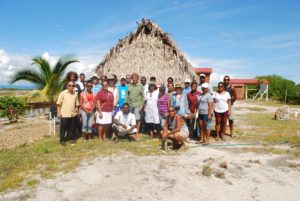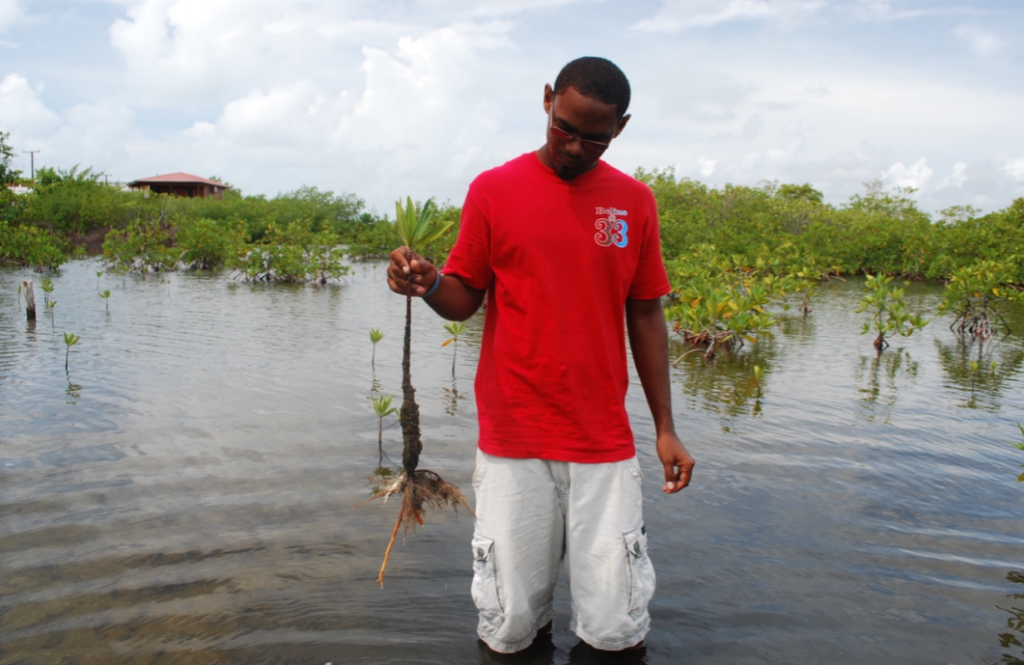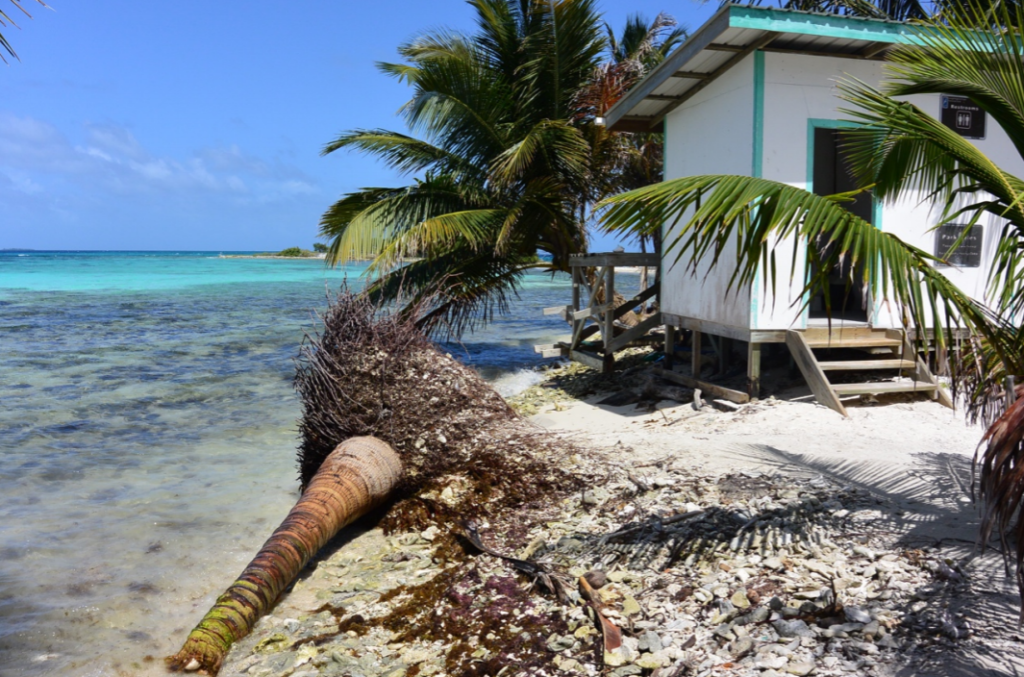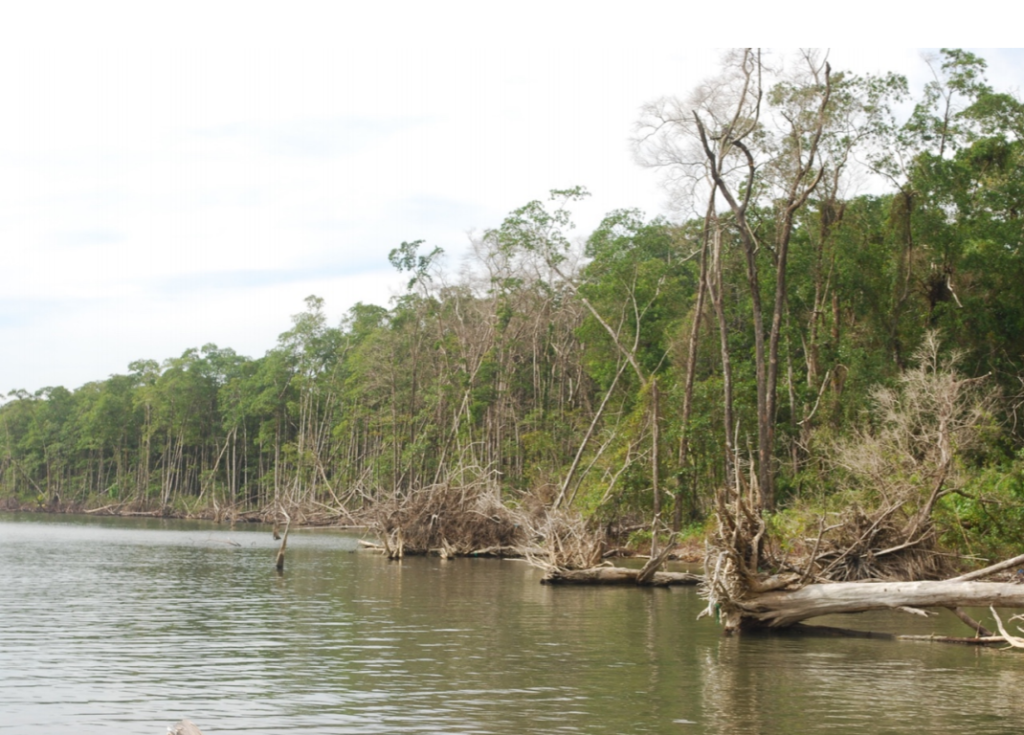Fragments of Hope, Belize
MANGROVE REFORESTATION
Coral reefs and mangroves are interconnected ecosystems that contribute significantly to reinforcing the integrity of Belize’s coastline and provide a habitat for a wide range of marine and avian species. However, with increasing unsustainable development practices, the health and function of mangroves are being affected.
Consequently, reforestation projects were established in the Placencia Lagoon to stabilize the coastline and restore the mangrove habitat. The primary reforestation technique in the Placencia Lagoon has been the use of transplants from natural nursery areas. Several known sites have had considerable success with some sites exhibiting mangrove survival of over 10 years.

The Riley Encasement Methodology (REM)
The Riley Encasement Method (REM) uses sustainable development technology to establish mangroves along high-energy shorelines where natural recruitment no longer occurs and where conventional planning methods are ineffective. It consists of a specialized encasement that has undergone extensive proof of concept.
These encasements facilitate the establishment of mangroves at extreme locations, allowing elevation adjustments within the encasements. Additionally, it provides mangroves protection from storms, the ability to adapt to extreme conditions, and with its translucence nature, fosters adequate light via the walls to stimulate growth.
In Belize, this method was adopted to successfully establish mangroves in poor conditions. This approach offers great potential for windward coastlines and offshore cayes that are affected by climate change and human activities.
REM TECHNICAL WORKSHOP

Fragments of Hope conducted a mangrove technical training to engage participants in constructive dialogue about reforestation efforts taking place in Belize. Lessons learned and results of previous mangrove reforestation efforts were shared with participants and introduced to a variety of reforestation methods. Technical presentations focused on reforestation case studies, avoiding maladaptation, reforestation techniques, hard engineering integration and introduction to the Riley Encasement Methodology.
 The session aimed to ensure that participants can prioritize coastal management interventions based on site vulnerability to natural and anthropogenic threats and to use the most effective method that would result in the highest survival potential. The training session included a visit to historical reforestation sites in the Placencia lagoon and to natural mangrove nurseries, and involved 26 participants, including representatives from the Department of Environment (DOE), The Belize Zoo, Southern Environmental Association (SEA), Coastal Zone Management Authority and Institute (CZMAI), Placencia Tour Guide Association (PTGA), other small organizations and private sectors.
The session aimed to ensure that participants can prioritize coastal management interventions based on site vulnerability to natural and anthropogenic threats and to use the most effective method that would result in the highest survival potential. The training session included a visit to historical reforestation sites in the Placencia lagoon and to natural mangrove nurseries, and involved 26 participants, including representatives from the Department of Environment (DOE), The Belize Zoo, Southern Environmental Association (SEA), Coastal Zone Management Authority and Institute (CZMAI), Placencia Tour Guide Association (PTGA), other small organizations and private sectors.
REM MANGROVES
Reforestation in high-wave environments is very challenging due to the extreme conditions that such efforts are required to overcome. The REM has been used at several sites in Belize to successfully established mangroves in such conditions. This approach offers great potential for windward coastlines and offshore cayes that are affected by climate change and human activities. Based on a thorough site assessment of the erosion status at Laughing Bird Caye, and the conditions affecting the site, REM mangroves were established in 2015. Mangrove leaders responsible to advance the reforestation work for Fragments of Hope have been monitoring the progress of the reforestation project. A total of 53 REM mangroves were established as part of the initial training and follow-up activities. A summary report of our reforestation plan can be accessed here: Mangrove Reforestation Plan.
REM SITES
PLACENCIA LAGOON
The growth of the tourism industry has resulted in unsustainable development practices that have led to the alteration of mangrove habitats that buffer the Placencia Lagoon. Where once were mangroves, are now landfills, infrastructures, and seawalls. Collaborative efforts between community leaders and landowners led to the reforestation of coastal properties with mangroves that have been nursery grown and transplanted. Several of this mangrove reforestation has been successful, with some showing over 10 years of successful growth.

In December 2015, a demonstration site was established in the Placencia Lagoon at an area where low-energy methods had been attempted several years ago with minimal success due to high boat traffic. There, a total of 12 REM mangroves were established aiming to increase awareness of this project. Despite collaborative efforts made between community leaders and landowners in the past, full support with landowners this time was challenging.
LAUGHING BIRD CAYE NATIONAL PARK
Laughing Bird Caye is well known for its sandy beaches and beautiful corals. The northwest side of the island is used as a primary landing area for visiting boats due to the wave action. With a history of shifting beaches throughout the year and high storm events, the island has seen a significant loss of beach and have affected existing vegetation and infrastructure.

Based on a thorough site assessment of the erosion status at LBCNP, the REM method was established in 2015 by several participants who gained hands-on training. 53 REM mangroves were established and subsequent trips followed to reinforce and expand. A total of 84 REMs were later established after storm events severely change the landscape and thus, substrate elevation.
BARRANCO VILLAGE
Barranco Village is the southernmost coastal community in Belize. Home to the indigenous Garinagu, the community is rich in history that can be dated back to the 1830s. The village contains a high abundance of vegetation along the coastline, community, and small cliffs. With no issue of coastal clearing, Barranco still succumbs to mangrove and coastal vegetation loss due to gradual erosion of the cliffs and even more recent, to incoming wave action and storm impacts.

In January 2016, 30 REM mangroves were established along the coast of Barranco. Unfortunately, the lack of financial upscaling and rural location led to limited monitoring. Later community fishers observe storm action had taken heed to the encasement.

 The session aimed to ensure that participants can prioritize coastal management interventions based on site vulnerability to natural and anthropogenic threats and to use the most effective method that would result in the highest survival potential. The training session included a visit to historical reforestation sites in the Placencia lagoon and to natural mangrove nurseries, and involved 26 participants, including representatives from the Department of Environment (DOE), The Belize Zoo, Southern Environmental Association (SEA), Coastal Zone Management Authority and Institute (CZMAI), Placencia Tour Guide Association (PTGA), other small organizations and private sectors.
The session aimed to ensure that participants can prioritize coastal management interventions based on site vulnerability to natural and anthropogenic threats and to use the most effective method that would result in the highest survival potential. The training session included a visit to historical reforestation sites in the Placencia lagoon and to natural mangrove nurseries, and involved 26 participants, including representatives from the Department of Environment (DOE), The Belize Zoo, Southern Environmental Association (SEA), Coastal Zone Management Authority and Institute (CZMAI), Placencia Tour Guide Association (PTGA), other small organizations and private sectors. 


